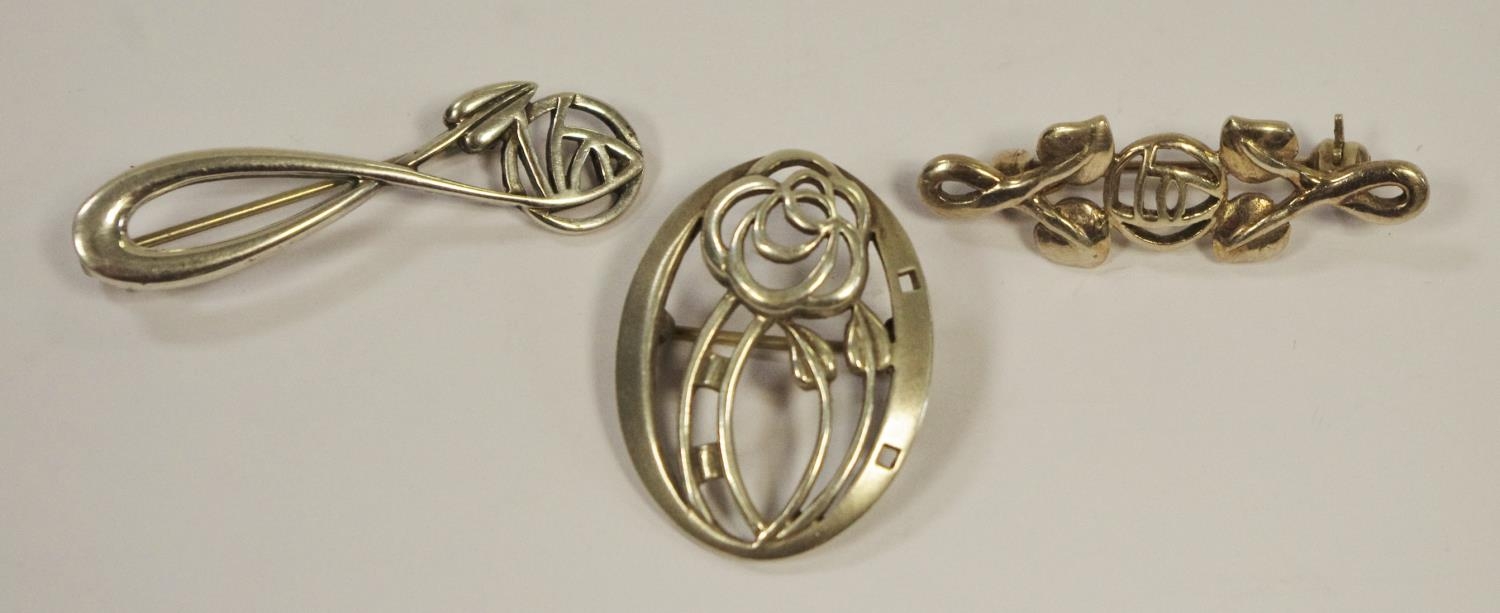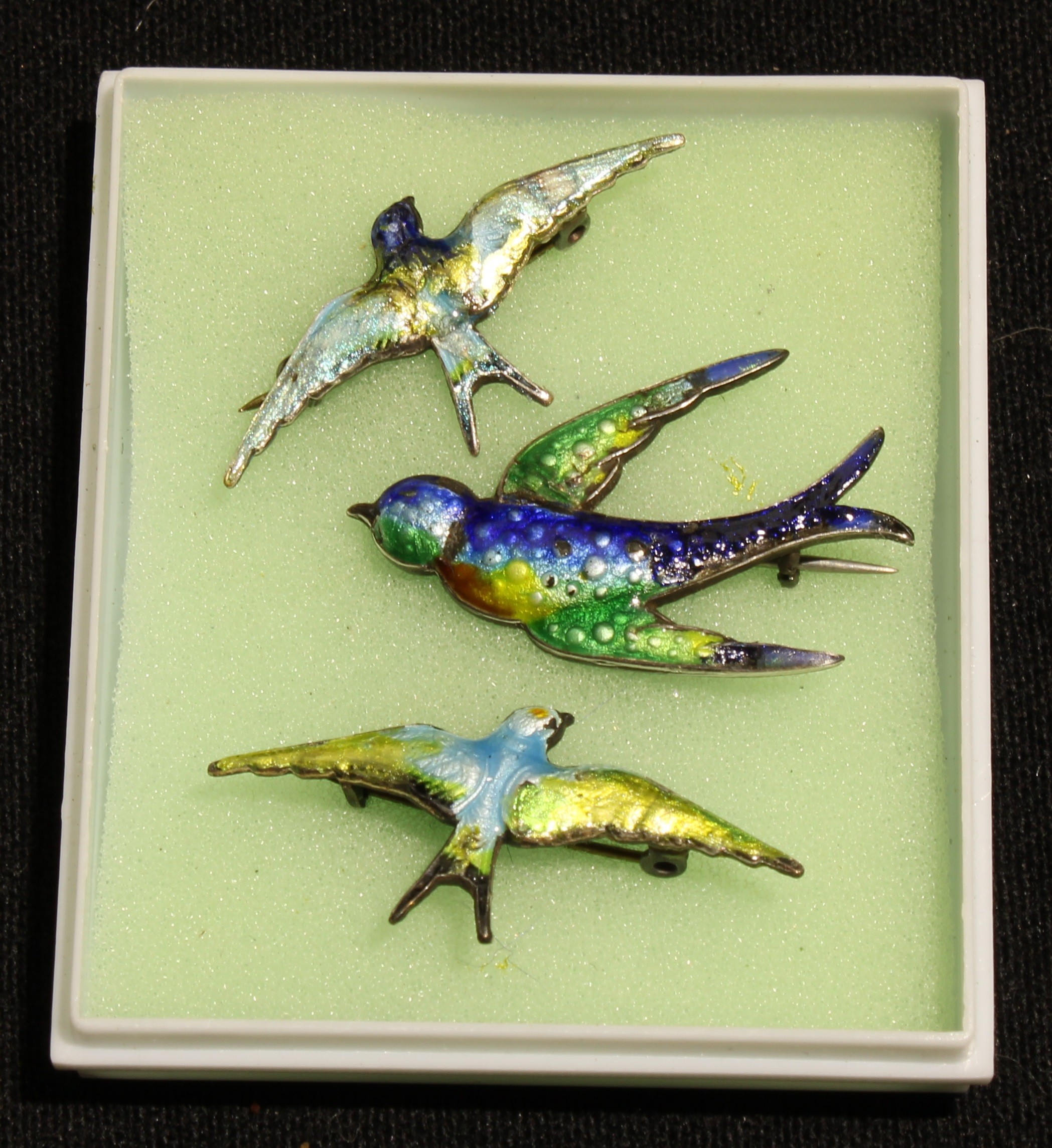THREE ART NOUVEAU BROOCHES, one brooch (possibly a former central plaque for choker), of openwork foliate design, decorated with green enamel plique-a-jour, with baroque pearl highlights, mounted in silver, with maker’s mark for Karl Hermann or Levinger & Bissinger, length 4.5cm, width 8.3cm A second brooch of Egyptian revival design, the central carved scarab in greyish-green hardstone highlighted by two blue cabochons, the wings decorated with green and turquoise enamel plique-a-jour, mounted in silver, with unidentified mark, width 12.4cm A third brooch of Egyptian revival design, the central faceted purple stones (possibly glass) highlighted with two similar stones, the wings decorated with green and turquoise enamel plique-a-jour, mounted in silver, with unidentified mark, width 12cm The designs of Art Nouveau jewellery first began to appeal to the masses during the period known as the Belle Époque (1890-1910), yet their popularity reached its zenith in the decade leading up to World War I. While the Edwardian sensibility was far more interested in stones than in their settings, an artier crowd during this time began to veer towards a more intricate type of jewellery with an increased focus on detailed craftsmanship. The work of Art Nouveau artists and jewellers was inspired by the natural world, which was exoticized in their creations to show curling lines and elaborate arabesques. Recurring motifs included dragonflies and peacocks, whose bold colours provided ideal grounds for beautiful enamel work and advanced metalworking techniques. Renowned jewellery designer and silversmith Heinrich Levinger was an early advocate of the Art Nouveau style from the town of Pforzheim in Southern-West Germany. Pforzheim was famous for its jewellery-making traditions from the mid-18th century, ensuring the small town was dubbed the “Golden City”. Levinger worked here during the latter part of the 19th century up and founded his workshop around the year 1881, when he was listed in a Pforzheim address book as a dealer in bijourterie wares. By 1893, Levinger’s workshop had become renowned for the creation of gold and silver wares and novelty items worked in silver and enamel, inspired by the waves of Art Nouveau and Japonisme trends which had spread throughout western Europe at the turn of the 20th century. The talented craftsman followed in the footsteps of emerging artists such as René Lalique who was hugely influential in pushing the boundaries of acceptable themes and materials in the world of jewellery design towards the end of the Victorian era. Heinrich Levinger died in 1899 and left his workshop to Emil Levinger, who sought to lead the firm in a new direction by producing more modern silver jewellery. Wishing to expand the firm, Emil was joined in 1903 by jewellery designer Karl Bissinger, who worked as artistic partner of alongside Emil. Together, the two became known as Levinger & Bissinger from 1904 onwards. They executed their own designs as well as those of other artists. Collaborations included the creationof Art Nouveau pieces with Austrian designer Otto Ptrutscher (1880-1949) and German designer Goerg Kleemann (1863-1932). Bissinger eventually left the firm in 1909, and Emil decided to return to the name of his predecessor, Heinrich Levinger, under which the workshop had experienced its original success. The first creations by German jeweller Karl Hermann were recorded in 1898, under the mention of his workshop in Pforzheim, Germany, in the same local address book as his contemporary Heinrich Levinger. Here, the firm advertised itself as a factory for jewellery and enamelled silverware. By 1902, the workshop had expanded enough for Hermann to require a business partner and he recruited his former jewellery technician Albert Speck to join him in running the bourgeoning business. From this time onwards the company used the mark ‘HS’, continuing to work under the name of Karl Hermann, even after he left the business to the s
THREE ART NOUVEAU BROOCHES, one brooch (possibly a former central plaque for choker), of openwork foliate design, decorated with green enamel plique-a-jour, with baroque pearl highlights, mounted in silver, with maker’s mark for Karl Hermann or Levinger & Bissinger, length 4.5cm, width 8.3cm A second brooch of Egyptian revival design, the central carved scarab in greyish-green hardstone highlighted by two blue cabochons, the wings decorated with green and turquoise enamel plique-a-jour, mounted in silver, with unidentified mark, width 12.4cm A third brooch of Egyptian revival design, the central faceted purple stones (possibly glass) highlighted with two similar stones, the wings decorated with green and turquoise enamel plique-a-jour, mounted in silver, with unidentified mark, width 12cm The designs of Art Nouveau jewellery first began to appeal to the masses during the period known as the Belle Époque (1890-1910), yet their popularity reached its zenith in the decade leading up to World War I. While the Edwardian sensibility was far more interested in stones than in their settings, an artier crowd during this time began to veer towards a more intricate type of jewellery with an increased focus on detailed craftsmanship. The work of Art Nouveau artists and jewellers was inspired by the natural world, which was exoticized in their creations to show curling lines and elaborate arabesques. Recurring motifs included dragonflies and peacocks, whose bold colours provided ideal grounds for beautiful enamel work and advanced metalworking techniques. Renowned jewellery designer and silversmith Heinrich Levinger was an early advocate of the Art Nouveau style from the town of Pforzheim in Southern-West Germany. Pforzheim was famous for its jewellery-making traditions from the mid-18th century, ensuring the small town was dubbed the “Golden City”. Levinger worked here during the latter part of the 19th century up and founded his workshop around the year 1881, when he was listed in a Pforzheim address book as a dealer in bijourterie wares. By 1893, Levinger’s workshop had become renowned for the creation of gold and silver wares and novelty items worked in silver and enamel, inspired by the waves of Art Nouveau and Japonisme trends which had spread throughout western Europe at the turn of the 20th century. The talented craftsman followed in the footsteps of emerging artists such as René Lalique who was hugely influential in pushing the boundaries of acceptable themes and materials in the world of jewellery design towards the end of the Victorian era. Heinrich Levinger died in 1899 and left his workshop to Emil Levinger, who sought to lead the firm in a new direction by producing more modern silver jewellery. Wishing to expand the firm, Emil was joined in 1903 by jewellery designer Karl Bissinger, who worked as artistic partner of alongside Emil. Together, the two became known as Levinger & Bissinger from 1904 onwards. They executed their own designs as well as those of other artists. Collaborations included the creationof Art Nouveau pieces with Austrian designer Otto Ptrutscher (1880-1949) and German designer Goerg Kleemann (1863-1932). Bissinger eventually left the firm in 1909, and Emil decided to return to the name of his predecessor, Heinrich Levinger, under which the workshop had experienced its original success. The first creations by German jeweller Karl Hermann were recorded in 1898, under the mention of his workshop in Pforzheim, Germany, in the same local address book as his contemporary Heinrich Levinger. Here, the firm advertised itself as a factory for jewellery and enamelled silverware. By 1902, the workshop had expanded enough for Hermann to require a business partner and he recruited his former jewellery technician Albert Speck to join him in running the bourgeoning business. From this time onwards the company used the mark ‘HS’, continuing to work under the name of Karl Hermann, even after he left the business to the s















Try LotSearch and its premium features for 7 days - without any costs!
Be notified automatically about new items in upcoming auctions.
Create an alert